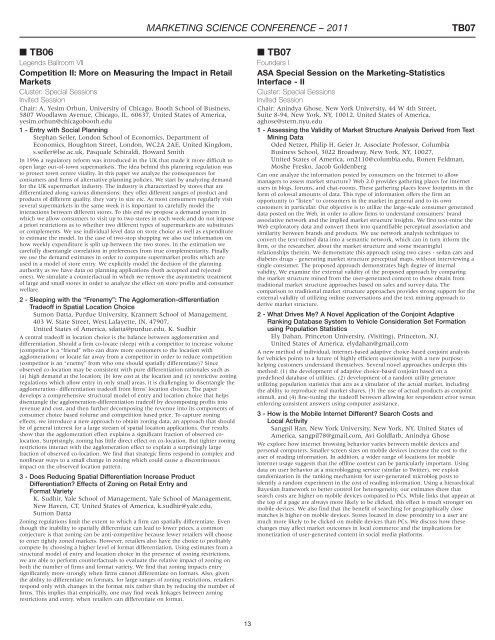2012 INFORMS Marketing Science Conference June 7
2012 INFORMS Marketing Science Conference June 7
2012 INFORMS Marketing Science Conference June 7
Create successful ePaper yourself
Turn your PDF publications into a flip-book with our unique Google optimized e-Paper software.
■ TB06<br />
Legends Ballroom VII<br />
Competition II: More on Measuring the Impact in Retail<br />
Markets<br />
Cluster: Special Sessions<br />
Invited Session<br />
Chair: A. Yesim Orhun, University of Chicago, Booth School of Business,<br />
5807 Woodlawn Avenue, Chicago, IL, 60637, United States of America,<br />
yesim.orhun@chicagobooth.edu<br />
1 - Entry with Social Planning<br />
Stephan Seiler, London School of Economics, Department of<br />
Economics, Houghton Street, London, WC2A 2AE, United Kingdom,<br />
s.seiler@lse.ac.uk, Pasquale Schiraldi, Howard Smith<br />
In 1996 a regulatory reform was introduced in the UK that made it more difficult to<br />
open large out-of-town supermarkets. The idea behind this planning regulation was<br />
to protect town centre vitality. In this paper we analyze the consequences for<br />
consumers and firms of alternative planning policies. We start by analyzing demand<br />
for the UK supermarket industry. The industry is characterized by stores that are<br />
differentiated along various dimensions: they offer different ranges of product and<br />
products of different quality, they vary in size etc. As most consumers regularly visit<br />
several supermarkets in the same week it is important to carefully model the<br />
interactions between different stores. To this end we propose a demand system in<br />
which we allow consumers to visit up to two stores in each week and do not impose<br />
a priori restrictions as to whether two different types of supermarkets are substitutes<br />
or complements. We use individual level data on store choice as well as expenditure<br />
to estimate the model. In the case of two-stop shopping we also use information on<br />
how weekly expenditure is split up between the two stores. In the estimation we<br />
carefully disentangle correlation in preferences from true complementarity. Finally<br />
we use the demand estimates in order to compute supermarket profits which are<br />
used in a model of store entry. We explicitly model the decision of the planning<br />
authority as we have data on planning applications (both accepted and rejected<br />
ones). We simulate a counterfactual in which we remove the asymmetric treatment<br />
of large and small stores in order to analyze the effect on store profits and consumer<br />
welfare.<br />
2 - Sleeping with the “Frenemy”: The Agglomeration-differentiation<br />
Tradeoff in Spatial Location Choice<br />
Sumon Datta, Purdue University, Krannert School of Management,<br />
403 W. State Street, West Lafayette, IN, 47907,<br />
United States of America, sdatta@purdue.edu, K. Sudhir<br />
A central tradeoff in location choice is the balance between agglomeration and<br />
differentiation. Should a firm co-locate (sleep) with a competitor to increase volume<br />
(competitor is a “friend” who can draw more customers to the location with<br />
agglomeration) or locate far away from a competitor in order to reduce competition<br />
(competitor is an “enemy” from who one should spatially differentiate)? Since<br />
observed co-location may be consistent with pure differentiation rationales such as<br />
(a) high demand at the location; (b) low cost at the location and (c) restrictive zoning<br />
regulations which allow entry in only small areas, it is challenging to disentangle the<br />
agglomeration- differentiation tradeoff from firms’ location choices. The paper<br />
develops a comprehensive structural model of entry and location choice that helps<br />
disentangle the agglomeration-differentiation tradeoff by decomposing profits into<br />
revenue and cost, and then further decomposing the revenue into its components of<br />
consumer choice based volume and competition based price. To capture zoning<br />
effects, we introduce a new approach to obtain zoning data, an approach that should<br />
be of general interest for a large stream of spatial location applications. Our results<br />
show that the agglomeration effect explains a significant fraction of observed colocation.<br />
Surprisingly, zoning has little direct effect on co-location. But tighter zoning<br />
restrictions interact with the agglomeration effect to explain a surprisingly large<br />
fraction of observed co-location. We find that strategic firms respond in complex and<br />
nonlinear ways to a small change in zoning which could cause a discontinuous<br />
impact on the observed location pattern.<br />
3 - Does Reducing Spatial Differentiation Increase Product<br />
Differentiation? Effects of Zoning on Retail Entry and<br />
Format Variety<br />
K. Sudhir, Yale School of Management, Yale School of Management,<br />
New Haven, CT, United States of America, k.sudhir@yale.edu,<br />
Sumon Datta<br />
Zoning regulations limit the extent to which a firm can spatially differentiate. Even<br />
though the inability to spatially differentiate can lead to lower prices, a common<br />
conjecture is that zoning can be anti-competitive because fewer retailers will choose<br />
to enter tightly zoned markets. However, retailers also have the choice to profitably<br />
compete by choosing a higher level of format differentiation. Using estimates from a<br />
structural model of entry and location choice in the presence of zoning restrictions,<br />
we are able to perform counterfactuals to evaluate the relative impact of zoning on<br />
both the number of firms and format variety. We find that zoning impacts entry<br />
significantly more strongly when firms cannot differentiate on formats. Also, given<br />
the ability to differentiate on formats, for large ranges of zoning restrictions, retailers<br />
respond only with changes in the format mix rather than by reducing the number of<br />
firms. This implies that empirically, one may find weak linkages between zoning<br />
restrictions and entry, when retailers can differentiate on format.<br />
MARKETING SCIENCE CONFERENCE – 2011 TB07<br />
13<br />
■ TB07<br />
Founders I<br />
ASA Special Session on the <strong>Marketing</strong>-Statistics<br />
Interface - II<br />
Cluster: Special Sessions<br />
Invited Session<br />
Chair: Anindya Ghose, New York University, 44 W 4th Street,<br />
Suite 8-94, New York, NY, 10012, United States of America,<br />
aghose@stern.nyu.edu<br />
1 - Assessing the Validity of Market Structure Analysis Derived from Text<br />
Mining Data<br />
Oded Netzer, Philip H. Geier Jr. Associate Professor, Columbia<br />
Business School, 3022 Broadway, New York, NY, 10027,<br />
United States of America, on2110@columbia.edu, Ronen Feldman,<br />
Moshe Fresko, Jacob Goldenberg<br />
Can one analyze the information posted by consumers on the Internet to allow<br />
managers to assess market structure? Web 2.0 provides gathering places for internet<br />
users in blogs, forums, and chat-rooms. These gathering places leave footprints in the<br />
form of colossal amounts of data. This type of information offers the firm an<br />
opportunity to “listen” to consumers in the market in general and to its own<br />
customers in particular. Our objective is to utilize the large-scale consumer generated<br />
data posted on the Web, in order to allow firms to understand consumers’ brand<br />
associative network and the implied market structure insights. We first text-mine the<br />
Web exploratory data and convert them into quantifiable perceptual association and<br />
similarity between brands and products. We use network analysis techniques to<br />
convert the text-mined data into a semantic network, which can in turn inform the<br />
firm, or the researcher, about the market structure and some meaningful<br />
relationships therein. We demonstrate this approach using two cases - sedan cars and<br />
diabetes drugs - generating market structure perceptual maps, without interviewing a<br />
single consumer. The proposed approach demonstrates high degree of internal<br />
validity. We examine the external validity of the proposed approach by comparing<br />
the market structure mined from the user-generated content to those obtain from<br />
traditional market structure approaches based on sales and survey data. The<br />
comparison to traditional market structure approaches provides strong support for the<br />
external validity of utilizing online conversations and the text mining approach to<br />
derive market structure.<br />
2 - What Drives Me? A Novel Application of the Conjoint Adaptive<br />
Ranking Database System to Vehicle Consideration Set Formation<br />
using Population Statistics<br />
Ely Dahan, Princeton University, (Visiting), Princeton, NJ,<br />
United States of America, elydahan@gmail.com<br />
A new method of individual, internet-based adaptive choice-based conjoint analysis<br />
for vehicles points to a future of highly efficient questioning with a new purpose:<br />
helping customers understand themselves. Several novel approaches underpin this<br />
method: (1) the development of adaptive choice-based conjoint based on a<br />
predefined database of utilities, (2) development of a random utility generator<br />
utilizing population statistics that acts as a simulator of the actual market, including<br />
the ability to reproduce real market shares, (3) the use of actual products as conjoint<br />
stimuli, and (4) fine-tuning the tradeoff between allowing for respondent error versus<br />
enforcing consistent answers using computer assistance.<br />
3 - How is the Mobile Internet Different? Search Costs and<br />
Local Activity<br />
Sangpil Han, New York University, New York, NY, United States of<br />
America, sangpil78@gmail.com, Avi Goldfarb, Anindya Ghose<br />
We explore how internet browsing behavior varies between mobile devices and<br />
personal computers. Smaller screen sizes on mobile devices increase the cost to the<br />
user of reading information. In addition, a wider range of locations for mobile<br />
internet usage suggests that the offline context can be particularly important. Using<br />
data on user behavior at a microblogging service (similar to Twitter), we exploit<br />
randomization in the ranking mechanism for user-generated microblog posts to<br />
identify a random experiment in the cost of reading information. Using a hierarchical<br />
Bayesian framework to better control for heterogeneity, our estimates show that<br />
search costs are higher on mobile devices compared to PCs. While links that appear at<br />
the top of a page are always more likely to be clicked, this effect is much stronger on<br />
mobile devices. We also find that the benefit of searching for geographically close<br />
matches is higher on mobile devices. Stores located in close proximity to a user are<br />
much more likely to be clicked on mobile devices than PCs. We discuss how these<br />
changes may affect market outcomes in local commerce and the implications for<br />
monetization of user-generated content in social media platforms.

















